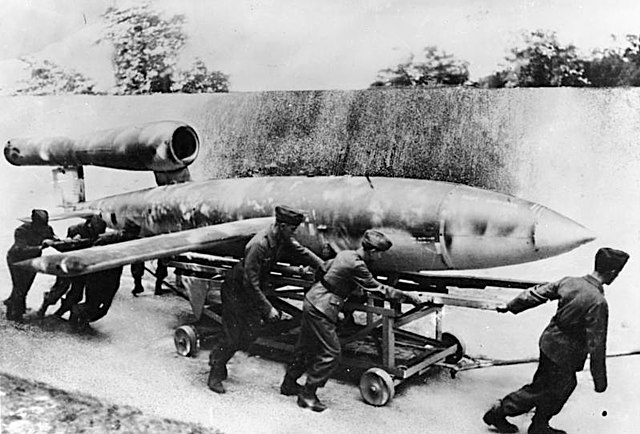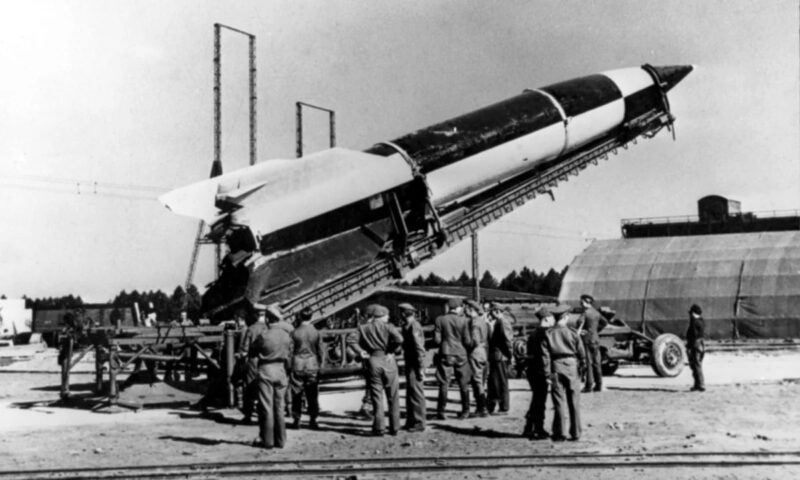Operations
Operations
Attacking the V-Rockets – 1944
It must have come as a shock to Britain, especially Londoners and others in the south, that just a week after D-Day, in the predawn hours of June 13, 1944, a jet-propelled German missile, designated the V–1, left a launching pad in the Pas de Calais area of France, crossed the English Channel and crashed near the centre of London. Within twenty-four hours, the Germans launched almost three hundred of these flying ‘buzz bombs’ against the United Kingdom.
Operation Crossbow was the code name for combined Anglo-American operations against the German long range reprisal weapons programme, the V-1 flying bomb and V-2 rocket, which were launched against Britain following D-Day.

A V-1 flying bomb is rolled out to the launch site.
(Credit: PK-Lysiak/Transocean-Europapress)
While the German rocket programme, the Vergeltungswaffen, was known to Allied planners, and attempts had been made to destroy it (see Operation Hydra in our December 2023 newsletter), for the British public this was an unexpected turn, when victory appeared imminent following the Normandy invasion.
The Allies reacted, under the operational name of Crossbow, initially attacking the launching sites with fighter-bombers and putting in place three levels of defence for London, airborne fighter aircraft (which could shoot down or even tip over the rockets), anti-aircraft guns and barrage balloons.
But as the attacks continued, the British requested the use of heavy bombers, then under overall direction of Eisenhower, as Supreme Allied Commander, to destroy the launch sites. Both Bomber Command’s Harris and the USAAF’s Spaatz objected to the diversion of his heavy bombers away from what they saw as their strategic missions, but in response to British losses Eisenhower ordered attacks against the launch sites saying, “these targets are to take first priority over everything except the urgent requirements of the Overlord [invasion of Normandy] battle”.
Over a quarter of the combined bomb tonnage in July and August were used against V-weapon sites, but many of the attacks were ineffective. While the bombers succeeded in destroying most of the ski sites, approximately 100 of them, and about 2,400 V-1 missiles in the production and delivery pipeline, the Germans replaced the ski sites with simpler, modified sites.
There were few outbuildings and little construction other than the launch facility itself. Modified sites could be built in eight days and were much easier to camouflage and hide.
The situation worsened in September 1944 because the Germans began launching the V–2, a rocket-powered ballistic missile. They were less accurate than V1 missiles, but since they travelled at the speed of sound, and so made no warning noise before impact, it was almost impossible to defend against them.

A V2 rocket being prepared for launch.
(Credit: Paul Popper/Popperfoto/Guardian)
The Allies responded by targeting not only the launching sites but also bombing the support installations. Crossbow also included a large raid on September 17 against Dutch target suspected as bases for Heinkel He 111s, which were being used to air-launch V-1s.
These bombing attacks were largely ineffective, as the V2s were fired from a mobile transporter-erector-launcher called a Meillerwagen which could be easily hidden when not in use. The German “vengeance” weapons were not neutralized until the Allied ground armies overran the launch sites. The raids cost the lives of more than 700 Allied airmen and the loss of 154 aircraft.
6,725 V-1s were launched at Britain. Of these, 2,340 hit London, causing 5,475 deaths, with 16,000 injured. 1,400 V-2s struck London, killing 2.754 civilians and injuring 6.523. Thousands of homes were destroyed, reminding many of the Blitz.
The vengeance weapons were nonetheless largely unsuccessful, the entire seven-month V-2 missile campaign delivered fewer high explosives on all the targeted cities than a single large RAF raid on Germany and an enormous economic drain on German defence resources and capability. Certainly not the means of turning the war that Hitler had demanded.